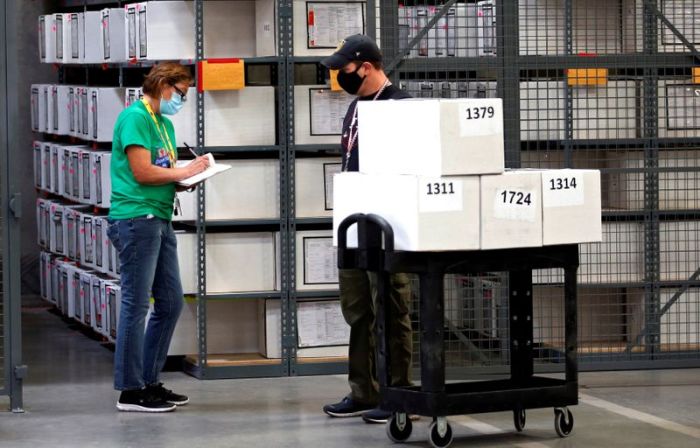WASHINGTON (Reuters) – U.S. homebuilding increased more than expected in October as the housing market continues to be driven by record low mortgage rates, but momentum could slow amid a resurgence in new COVID-19 infections that is putting strain on the economic recovery.
The report from the Commerce Department on Wednesday also showed building permits unchanged at a 13-1/2-year high. It followed on the heels of data on Tuesday showing the smallest gain in retail sales in October since the recovery from the pandemic started in May. The economy is slowing as more than $3 trillion in government coronavirus relief dries up.
Daily new COVID-19 cases have been exceeding 100,000 since early this month, pushing the number of infections in the United States above 11 million, according to a Reuters tally. Several states and local governments have imposed restrictions on businesses, raising fears that the resulting weak demand could unleash a fresh wave of layoffs that could reverberate across the economy and slow the housing market’s run.
“The million dollar question remains how long the recovery in housing can continue as the shocking number of new coronavirus cases is paralyzing commerce in many parts of the country and leading to new restrictions and lockdowns,” said Chris Rupkey, chief economist at MUFG in New York.
Housing starts rose 4.9% to a seasonally adjusted annual rate of 1.530 million units last month. That lifted homebuilding closer to its pace of 1.567 million units in February. Economists polled by Reuters had forecast starts would rise to a rate of 1.460 million units in October.
Permits for future homebuilding were unchanged at a rate of 1.545 million units in October, the highest since March 2007.
The densely populated South region accounted for 56.1% of homebuilding last month. Groundbreaking activity also rose in the West and Midwest, but tumbled in the Northeast.
Homebuilding surged 14.2% on a year-on-year basis.
Single-family homebuilding, the largest share of the housing market, raced 6.4% to a seasonally adjusted annual rate of 1.179 million units last month, the highest level since April 2007.
Single-family starts have increased for six straight months. This segment of the market is being boosted by the pandemic, which has seen at least 21% of the labor force working from home. That has led to a migration from city centers to suburbs and other low-density areas as Americans seek out spacious accommodation for home offices and schools.
“The South and inland and mountain regions of the West are seeing a huge influx of residents from the large metro areas in the Northeast and West Coast,” said Mark Vitner, a senior economist at Wells Fargo Securities in Charlotte, North Carolina. “Just over 80% of all single-family homes built over the past year have been in the South or West, which means that construction can continue at a much higher pace during the winter months than in prior years.”
A survey on Tuesday showed confidence among single-family homebuilders rose to an all-time high in November. But builders said “lot and material availability is holding back some building activity.”
Single-family building permits climbed 0.6% to a rate of 1.120 million units in October.
A separate report on Wednesday from the Mortgage Bankers Association showed applications for loans to buy a home increased 4% last week from a week earlier.
The coronavirus recession, which started in February, has disproportionately affected lower-wage earners. At least 20 million people are on unemployment benefits.
The PHLX housing index was trading higher, outperforming a mixed U.S. stock market. The dollar slipped against a basket of currencies. Prices of longer-dated U.S. Treasuries were trading higher.
BIGGER FOOTPRINT
Though the housing market accounts for a fraction of gross domestic product, it has a bigger economic footprint. Its continued strength should help to keep the economy afloat even as GDP growth is expected to decelerate significantly in the fourth quarter after a historic performance in the July-September period.
Homebuilding is being driven by lean inventories, especially for previously-owned homes, and low mortgage rates. The 30-year fixed mortgage rate is around an average of 2.84%, according to data from mortgage finance agency Freddie Mac.
Starts for the volatile multi-family segment were unchanged at a pace of 351,000 units. Building permits for multi-family housing projects fell 1.6% to a rate of 425,000 units. It was the third straight monthly decline.
“This is an indication that developers are reining in investment as rental vacancy rates have risen,” said Matthew Pointon, property economist at Capital Economics in New York.
According to Wells Fargo Securities’ Vitner, rental data also suggest a shift in renter preferences away from urban lifestyle apartments to suburban apartments that offer more outdoor amenities.
Housing completions fell 4.5% to a rate of 1.343 million units last month. Realtors estimate that housing starts and completion rates need to be in a range of 1.5 million to 1.6 million units per month to close the inventory gap. The stock of housing under construction increased 1.2% to a rate of 1.224 million units, the highest since December 2006.
(Reporting by Lucia Mutikani; Editing by Paul Simao)

























